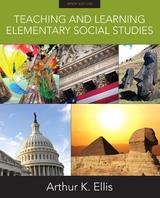
Teaching and Learning Elementary Social Studies
Pearson (Verlag)
978-0-205-48394-5 (ISBN)
- Titel erscheint in neuer Auflage
- Artikel merken
If you think you know Ellis, think again! Widely admired for its warm voice and abundance of children’s art and writing, Teaching and Learning Elementary Social Studies integrates constructivist philosophies of active learning with the essential knowledge, basic skills, and positive values required of citizens in a healthy and diverse democracy. And every copy is packaged with a free Atlas!
All chapters include end-of-chapter activities (Explorations), and reference lists (Continue the Journey)
Preface
Chapter One: Social Studies Education: Definitions and Rationales
A Rationale for Social Studies Education
Keys to Exemplary Social Studies Programs
Social Studies Curriculum Patterns
The Widening Horizons Curriculum
The Spiral Curriculum
Environments for Social Studies Learning
A Constructivist Environment for Learning
Productive, Reflective Thinking
Provisions for Learner Differences
The Roles of the Teacher
Summary
Explorations
Reflect On…
In the Field
For Your Portfolio
Continue the Journey
Chapter Two: Diversity, Multiculturalism and Pluralism in the Social Studies Classroom
Diversity in the United States and the Classroom
The Role of Social Studies Education in Promoting Pluralism and Diversity
Cultural Sensitivity in Social Studies Curricula
Toward a Culturally Responsive Learning Environment
Cultural Sensitivity: The Teacher as Learner
Preparing Children for a Diverse World
Summary
Explorations
Reflect On…
In the Field
For Your Portfolio
Continue the Journey
Chapter Three: Setting Standards: The Knowledge Base for the Social Studies
The Nature of Knowledge
Knowledge Received
Knowledge Discovered
Knowledge Constructed
Keys to Progressive Education
Keys to Essentialist Education
The National Council for the Social Studies Standards as a Guide to the Knowledge Base
What Should Children Know?
The Social Science Disciplines
Anthropology
What Is Anthropology?
What Do Anthropologists Do?
Selected Anthropological Concepts
Keys to Anthropology
Economics
What Is Economics?
What Do Economists Do?
Selected Economic Concepts
Keys to Economics
Geography
What Is Geography?
What Do Geographers Do?
Selected Geographic Concepts
Keys to Geography
History
What Is History?
What Do Historians Do?
Keys to History
Sociology
What Is Sociology?
What Do Sociologists Do?
Selected Sociological Concepts
Keys to Sociology
Political Science
What Is Political Science?
What Do Political Scientists Do?
Selected Political Science Concepts
Keys to Political Science
Current Events
Criteria for Successful Current Events Sessions
Summary
Explorations
Reflect On…
In the Field
For Your Portfolio
Continue the Journey
Chapter Four: Developmentally Appropriate Social Studies: Theory and Practice
Time-Tested Social Studies Practices
The doctrine of interest
Active learning
Project learning
Parent involvement
Teambuilding
Encouraging individuals
Reflection
Setting Conditions for Meaningful Learning: Concept Learning
In the Classroom: The American Revolution
In the Classroom: On the Playground
Current Events: Focus on Holidays and Special Occasions
Children’s Natural Tendencies
Encouraging High Achievement
Keys to High Achievement
Encouraging Thoughtfulness
Encouraging Creativity
Summary
Explorations
Reflect On…
In the Field
For Your Portfolio
Continue the Journey
Chapter Five: Planning for Social Studies Teaching and Learning
Teachers as Decision Makers
Motivation
Current Events: Focus on Planning
Retention
Transfer of learning
Planning for Long-Range Goals
Planning Lessons and Activities
Mechanics
Substance
Keys to Developing a Successful Unit
Teaching Concepts
Developing Concepts
In the Classroom: Teaching Supply and Demand Through Problem-Solving
In the Classroom: Defining Culture Through Webbing
Teaching Skills
In the Classroom: Teaching Estimation
Teaching Values
Planning and Developing Units
What Is a Unit?
How Long Should a Unit Be?
Developing a Unit Plan
Creating an Instructional Design
In the Classroom: An Archaeology Unit
Summary
Explorations
Reflect On…
In the Field
For Your Portfolio
Continue the Journey
Sample Lesson 5.1: What Season Is It?
Sample Lesson 5.2: Aleut Maps
Chapter Six: Strategies for Social Studies Teaching and Learning
What Research Says About Social Studies Teaching and Learning
Direct Instruction Strategies
Teacher Presentation
Keys to Effective Teacher Presentations
Class Discussion
Demonstration
Keys to Direct Instruction
Indirect Instruction Strategies
Role-Play
Interest Centers
Current Events: Focus on Strategies
Group Investigations and Projects
Independent Study and Presentations
In the Classroom: Finding Students’ Interests
Reflective Thinking
In the Classroom: Reflective Thinking: An Incident in Human Behavior
In the Classroom: Reflective Thinking: Looking Forward and Looking Back
Brainstorming
Creative Expression
In the Classroom: Creative Expression: Nursery Rhyme Newspaper Stories
Keys to Creativity
Content Analysis
In the Classroom: Content Analysis: Nursery Rhymes
In the Classroom: Content Analysis: Textbooks
Differentiated Assignments
In the Classroom: Differentiated Assignments: The Pioneer Treks
In the Classroom: Differentiated Assignments: Archeology
Jigsaw/ Peer Teaching and Cooperative Learning
In the Classroom: Jigsaw or Cooperative Learning: The American Revolution
Simulations
In the Classroom: Simulations: Starpower
In the Classroom: Simulations: Bafa Bafa
Observations on Indirect Instruction
Summary
Explorations
Reflect On…
In the Field
For Your Portfolio
Continue the Journey
Sample Lesson 6.1: The Settlement of the United States
Sample Lesson 6.2: The Zuni Culture
Sample Lesson 6.3: The Bicycle Path
Chapter Seven: Assessing Social Studies Learning
An Overview of Assessment
Why Assess?
What Should Be Assessed?
How Should We Assess?
In the Classroom: Assessing a Lesson
Integrated Assessment Strategies
Writing About Learning
Talking About Learning
Illustrating Learning
Current Events: Focus on Assessing Critical Thinking Skills
Getting Parents Involved
Keys to Involving Parents
Assessing Assessment: Why Is It Important?
Testing and Assessment
Essay Tests: Extended Response Questions
Objective Tests: Selected Response Questions
Portfolio Assessment
Assessing Your Own Effectiveness
Keys to Being an Effective Assessor
Standards and Achievement
Knowledge
Understanding
Appreciation
Summary
Explorations
Reflect On…
In the Field
For Your Portfolio
Continue the Journey
Chapter Eight: Inquiry, Discovery, and Problem-Solving: Children as Researchers
Inquiry, Discovery Learning, and Problem-Solving
Real and Contrived Problems
In the Classroom: A Contrived Problem
In the Classroom: A Real Problem
Differences and Similarities
Reflective Thinking as a Follow-up to Inquiry
Three Types of Inquiry Research
Descriptive Research
In the Classroom: The Five Senses Game
Survey Research
In the Classroom: A Playground Investigation
In the Classroom: A Halloween Study
Current Events: Focus on Gender Roles
In the Classroom: A Weather Stations Survey
Experimental Research
In the Classroom: The Great Paper-Towel Experiment
In the Classroom: Health-Drink Design
Assessment and Inquiry
Metacognition and Inquiry
Summary
Explorations
Reflect on…
In the Field
For Your Portfolio
Continue the Journey
Sample Lesson 8.1: The $1.50 Inquiry
Chapter Nine: Making History Come Alive
What Is History?
Why Should Young People Study History?
The Power of Story-Telling as History
Biographies
Historical Fiction
Using Historical Sources
In the Classroom: Thomas Jefferson and Meriwether Lewis
Children as Historians
Oral History
Current Events: Focus on Personal History
Personal Histories
Time Lines
“Experiential” History
In the Classroom: Did the Chinese Discover America?
Summary
Explorations
Reflect on…
In the Field
For Your Portfolio
Continue the Journey
Sample Lesson 9.1 Nevada Trek
Sample Lesson 9.2: Role-Playing the Civil War
Chapter Ten: Exploring Our Geographic World
Understanding the Tools of Geography
The Five Themes of Geography
Helping Students Learn to Make and Read Maps
Mental Maps
In the Classroom: Drawing from a Mental Map
Current Events: Focus on the Weather Page
Traverse Maps
In the Classroom: Conceptualizing a Common Traverse
Aerial Photographs and Maps
Changing the Scale of a Map
Keys to Understanding the Language of Maps
Understanding Map Projections and Globes
In the Classroom: A World Globe Activity
Helping Students Learn to Use Maps
In the Classroom: Mapping Directions
Considering Variables in Finding Your Way
In the Classroom: Mapping Variables
Studying Land Use Change
In the Classroom: Learning Geography from Chocolate Bars
Understanding Perspective
In the Classroom: Four-Color Mapping Theory
Estimating Distances
Summary
Explorations
Reflect on…
In the Field
For Your Portfolio
Continue the Journey
Sample Lesson 10.1: Learning a New Environment
Sample Lesson 10.2: Map Mileage
Sample Lesson 10.3: Map Making
Chapter Eleven: Teaching and Learning Values, Character Education, and Moral Development
The Meaning of Values, Character, and Morality in Elementary School Learning
Procedural Values: The Strategies of Inquiry and Reflection
Considering the Social Context
What Really Matters?
The Moral Life of Schools
Teaching Values, Character, and Morality
Strategies for Teaching Values
Keys to Effective Values Education
Using Moral Dilemmas
In the Classroom: Role-Playing a Moral Dilemma
Models of Character Education, Values Realization, and Moral Development
Character Education
Values Realization
Moral Development
Gender and Moral Development
Summary
Explorations
Reflect on…
In the Field
For Your Portfolio
Continue the Journey
Sample Lesson Plan 11.1: Writing Fables
Chapter Twelve: Social Studies and Curriculum Connections: Integrated Studies
Projects: The Building Blocks of Integrated Study
Characteristics of Good Projects
Group versus Individual Projects
Kinds of Projects
In the Classroom: A Sample Project: Constructing a Greenbelt
Keys to Creating Effective Projects
Significant Themes for Integration
Cause and Effect
Commonality and Diversity
Systems and Patterns
Cycles and Change
Scale and Symmetry
Interaction and Relationships
Time and Space
Equilibrium and Disequilibrium
Summary
Explorations
Reflect on…
In the Field
For Your Portfolio
Continue the Journey
Chapter Thirteen: Social Studies and the Literacy Connection
Reading and Classroom Life
Keys to Early Literacy: Parents
Literacy and Democracy
Reading and Writing
Experience and Discussion
Social Studies and Language Development
Interpreting Text
Journal Writing
The Writing Process
In the Classroom: Writing Descriptions
The Spoken Word
Public Speaking
Small Group Speaking
Informal Talks
Group Presentations
Electronic Literacy
Summary
Explorations
Reflect on…
In the Field
For Your Portfolio
Continue the Journey
Sample Lesson 13.1: Cinderella
Chapter Fourteen: Teaching and Learning Responsible Citizenship
What Is the Citizen’s Role in American Democracy?
Citizenship Is Participating in Society
Citizenship Is Serving the Community
Effective Citizenship: An Interview With JoAnne Buggey
Citizenship Is Understanding Conflict
What Do Children Need to Know To Be Active Citizens?
Knowledge versus Information
Keys to Being a Well-Prepared Citizen
What Can You Do to Help Your Students Become Active Citizens?
Formal Strategies for Citizenship Education
Informal Strategies for Citizenship Education
Research Findings in Civic Education
Effective Citizenship Education
Keys to Effective Citizenship Education
Community Service
Decision-Making
In the Classroom: An Experiment with Free Time
The Meaning of Citizenship: A Global Perspective
An Interview with John J. Cogan
A Citizenship Test: How Do You Score?
Summary
Explorations
Reflect on…
In the Field
For Your Portfolio
Continue the Journey
Sample Lesson 14.1: A Classroom Civics Meeting
Sample Lesson 14.1: A Candidate Debate
Chapter Fifteen: Reflective Thinking: The Essence of Social Studies
Keys to Reflective Thinking
How Reflective Thought Develops
Constructivist Thought and Social Studies
Social Studies Strategies for Reflection
Thinking Strategies
Problem-Solving Strategies
Crossing the Frontier to Active Reflective Learning
The Emotional/ Intellectual Landscape
Keys to Teacher Beliefs
Summary
Explorations
Reflect on…
In the Field
For Your Portfolio
Continue the Journey
| Erscheint lt. Verlag | 1.6.2006 |
|---|---|
| Sprache | englisch |
| Maße | 194 x 245 mm |
| Gewicht | 854 g |
| Themenwelt | Schulbuch / Wörterbuch |
| Sozialwissenschaften ► Pädagogik | |
| ISBN-10 | 0-205-48394-1 / 0205483941 |
| ISBN-13 | 978-0-205-48394-5 / 9780205483945 |
| Zustand | Neuware |
| Haben Sie eine Frage zum Produkt? |
aus dem Bereich



